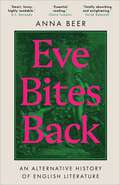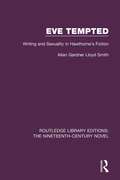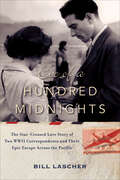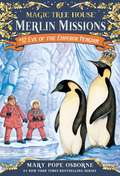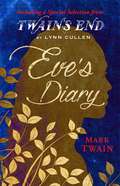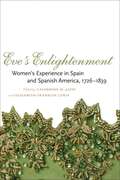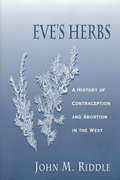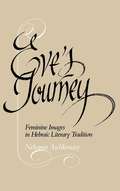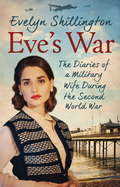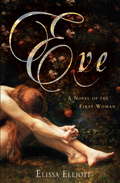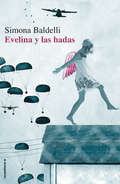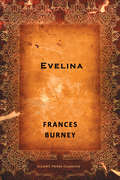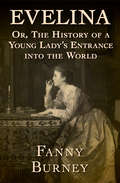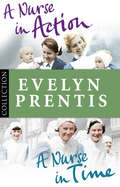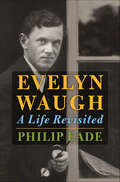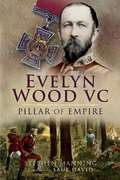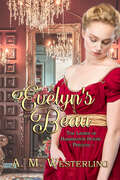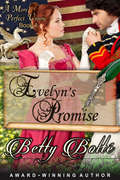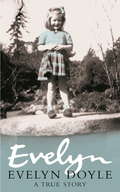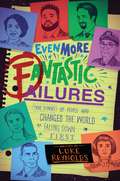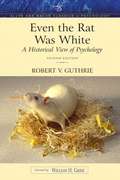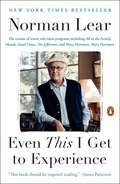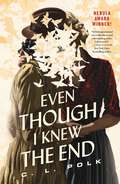- Table View
- List View
Eve Bites Back: An Alternative History of English Literature
by Anna BeerWarned not to write – and certainly not to bite – these women put pen to paper anyway and wrote themselves into history. From the fourteenth century through to the present day, women who write have been understood as mad, undisciplined or dangerous. Female writers have always had to find ways to overcome or challenge these beliefs. Some were cautious and discreet, some didn&’t give a damn, but all lived complex, eventful and often controversial lives. Eve Bites Back places the female contemporaries of Chaucer, Shakespeare and Milton centre stage in the history of literature in English, uncovering stories of dangerous liaisons and daring adventures. From Julian of Norwich, Margery Kempe, Aemilia Lanyer and Anne Bradstreet, to Aphra Behn, Mary Wortley Montagu, Jane Austen and Mary Elizabeth Braddon, these are the women who dared to write.
Eve Tempted: Writing and Sexuality in Hawthorne's Fiction (Routledge Library Editions: The Nineteenth-Century Novel #19)
by Allan Gardner Lloyd SmithFirst published in 1984, this book offers a unique interpretation of Hawthorne’s work, making use of perspectives opened up by Derrida in his work on Rousseau. It offers a psycho-biography of the author as discoverable in the texts and avoids a simplistic Freudian analysis. In doing so, it illuminates the work and re-opens Hawthorne’s texts to creative discussion. This book will be of interest to those studying 19th century literature.
Eve of a Hundred Midnights: The Star-Crossed Love Story of Two WWII Correspondents and Their Epic Escape Across the Pacific
by Bill LascherThe unforgettable true story of two married journalists on an island-hopping run for their lives across the Pacific after the Fall of Manila during World War II—a saga of love, adventure, and danger.On New Year’s Eve, 1941, just three weeks after the attack on Pearl Harbor, the Japanese were bombing the Philippine capital of Manila, where journalists Mel and Annalee Jacoby had married just a month earlier. The couple had worked in China as members of a tight community of foreign correspondents with close ties to Chinese leaders; if captured by invading Japanese troops, they were certain to be executed. Racing to the docks just before midnight, they barely escaped on a freighter—the beginning of a tumultuous journey that would take them from one island outpost to another. While keeping ahead of the approaching Japanese, Mel and Annalee covered the harrowing war in the Pacific Theater—two of only a handful of valiant and dedicated journalists reporting from the region.Supported by deep historical research, extensive interviews, and the Jacobys’ personal letters, Bill Lascher recreates the Jacobys’ thrilling odyssey and their love affair with the Far East and one another. Bringing to light their compelling personal stories and their professional life together, Eve of a Hundred Midnights is a tale of an unquenchable thirst for adventure, of daring reportage at great personal risk, and of an enduring romance that blossomed in the shadow of war.
Eve of the Emperor Penguin
by Mary Pope Osborne Sal MurdoccaThe #1 bestselling chapter book series of all time celebrates 25 years with new covers and a new, easy-to-use numbering system!Jack and Annie arrive on the one continent they haven’t visited before: Antarctica! What can they hope to learn about happiness in such a barren place? Only the penguins know for sure…Jack and Annie are about to find out!Formerly numbered as Magic Tree House #40, the title of this book is now Magic Tree House Merlin Mission #12: Eve of the Emperor Penguin.Did you know that there’s a Magic Tree House book for every kid?Magic Tree House: Adventures with Jack and Annie, perfect for readers who are just beginning chapter booksMerlin Missions: More challenging adventures for the experienced readerSuper Edition: A longer and more dangerous adventureFact Trackers: Nonfiction companions to your favorite Magic Tree House adventuresHave more fun with Jack and Annie at MagicTreeHouse.com
Eve of the Emperor Penguin (Magic Tree House Merlin Missions #12)
by Mary Pope Osborne Sal MurdoccaJACK AND ANNIE continue their quest for the secrets of happiness--secrets they need to save Merlin. This time, the Magic Tree House takes them to the one continent they haven't visited before: Antarctica! What can they hope to learn about happiness in such a barren place? Only the penguins know for sure . . . Jack and Annie are about to find out! From the Hardcover edition.
Eve's Diary (The\works Of Samuel Clemens)
by Mark TwainMark Twain's comic short story is now available as an ebook, including an extended excerpt from Twain's End by Lynn Cullen, a fictionalized imagining of the personal life of America's most iconic writer, Mark Twain, and his close relationship with his personal secretary.
Eve's Enlightenment: Women's Experience in Spain and Spanish America, 1726-1839
by Catherine M. Jaffe Elizabeth Franklin LewisEve's portrayal in the Bible as a sinner and a temptress seemed to represent -- and justify -- women's inferior position in society for much of history. During the Enlightenment, women challenged these traditional gender roles by joining the public sphere as writers, intellectuals, philanthropists, artists, and patrons of the arts. Some sought to reclaim Eve by recasting her as a positive symbol of women's abilities and intellectual curiosity. In Eve's Enlightenment, leading scholars in the fields of history, art history, literature, and psychology discuss how Enlightenment philosophies compared to women's actual experiences in Spain and Spanish America during the period. Relying on newspaper accounts, poetry, polemic, paintings, and saints' lives, this diverse group of contributors discuss how evolving legal, social, and medical norms affected Hispanic women and how art and literature portrayed them. Contributors such as historians Mónica Bolufer Peruga and María Victoria López-Cordón Cortezo, art historian Janis A. Tomlinson, and literary critic Rebecca Haidt also examine the contributions these women's experiences make to a transatlantic understanding of the Enlightenment. A common theme unites many of the essays: while Enlightenment reformers demanded rational equality for men and women, society increasingly emphasized sentiment and passion as defining characteristics of the female sex, leading to deepening contradictions. Despite clear gaps between Enlightenment ideals and women's experiences, however, the contributors agree that the women of Spain and Spanish America not only took part in the social and cultural transformations of the time but also exerted their own power and influence to help guide the Spanish-speaking world toward modernity.The first interdisciplinary collection published in English, Eve's Enlightenment offers a wealth of information for scholars of eighteenth-century Spanish history, literature, art history, and women's studies. An introduction by editors Catherine M. Jaffe and Elizabeth Franklin Lewis provides helpful historical and contextual information.
Eve's Herbs: A History of Contraception and Abortion in the West
by John M. RiddleIn Contraception and Abortion from the Ancient World to the Renaissance, John Riddle showed, through extraordinary scholarly sleuthing, that women from ancient Egyptian times to the fifteenth century had relied on an extensive pharmacopoeia of herbal abortifacients and contraceptives to regulate fertility. In Eve's Herbs, Riddle explores a new question: If women once had access to effective means of birth control, why was this knowledge lost to them in modern times? Beginning with the testimony of a young woman brought before the Inquisition in France in 1320, Riddle asks what women knew about regulating fertility with herbs and shows how the new intellectual, religious, and legal climate of the early modern period tended to cast suspicion on women who employed "secret knowledge" to terminate or prevent pregnancy. Knowledge of the menstrual-regulating qualities of rue, pennyroyal, and other herbs was widespread through succeeding centuries among herbalists, apothecaries, doctors, and laywomen themselves, even as theologians and legal scholars began advancing the idea that the fetus was fully human from the moment of conception. Drawing on previously unavailable material, Riddle reaches a startling conclusion: while it did not persist in a form that was available to most women, ancient knowledge about herbs was not lost in modern times but survived in coded form. Persecuted as "witchcraft" in centuries past and prosecuted as a crime in our own time, the control of fertility by "Eve's herbs" has been practiced by Western women since ancient times.
Eve's Journey
by Nehama AschkenasyIn Eve's Journey, Nehama Aschkenasy traces the migration of several female images and feminine situations from their early appearances in Biblical writings to their incarnations in modern Hebraic literature. Focusing on the evolution of early female archetypes and prototypes, Aschkenasy uncovers the ancient roots of modern female characters and traces the changing cultural perceptions of women in Hebraic letters.The author draws on the vast body of Hebraic literary documents to illustrate how the female character is a mirror of her times as well as being a product of her creator''s imagination and conception of the woman's role in society and in fiction. The historical spectrum, provided by a discussion of Biblical narratives, Midrashic sources, documents of the Jewish mystics, Hasidic tales, and modern Hebrew works, allows an understanding of the metamorphosis that the female figure has experienced in her literary odyssey.
Eve's War: The diaries of a military wife during the second world war
by Barbara Fox Evelyn ShillingtonTHE DIARIES OF A MILITARY WIFE DURING THE SECOND WORLD WARIn 1935, Evelyn Shillington started a diary, little knowing the years of turmoil it would cover, and how insightful her experiences as an army wife would be to the following generations.Eve joined her beloved husband, Captain Rex Shillington, on his postings, giving her a unique view into army life. Through the abdication crisis, to the turbulent years of the WWII and ending in war-ravaged Italy, Eve documented it all with an inimitable spirit and brave humour.The diaries lay forgotten in an attic for years until an enterprising antiques dealer discovered them by chance. Published seventy years after Eve wrote in her diary for the last time, they offer a fascinating first-hand account into life on the home front.Readers love EVE'S WAR:'Enlightening and well written''What a brilliant read''Such an interesting account and in great detail too''It's a book you just want to carry on reading'
Eve: A Novel of the First Woman
by Elissa ElliottIn their world they are alone...a family haunted by banishment, struggling for survival in a harsh new land. A woman who has borne and buried children, Eve sees danger shadowing those she loves, while her husband drifts further and further from the man he was in the Garden, blinded by his need to rebuild a life outside of Eden. One daughter, alluring, self-absorbed Naava, turns away from their beliefs. Another, crippled, ever-faithful Aya, harbors a fateful secret, while brothers Cain and Abel become adversaries, and Dara, the youngest, is chosen for a fate of her own. In one hot, violent summer, by the shores of the muddy Euphrates, strangers arrive on their land. New gods challenge their own. And for Eve, a time of reckoning is at hand. The woman who once tasted the forbidden fruit of paradise sees her family unraveling - as brother turns on brother, culminating in a confrontation that will have far-reaching consequences for them all. From a woman's first awakening to a mother's innermost hopes and fears, from moments of exquisite tenderness to a climax of shocking violence, Eve takes us on a breathtaking journey of the imagination. A novel that has it all - romantic love, lust, cruelty, heroism, envy, sacrifice, murder - Eve is a work of mesmerizing literary invention.
Evelina y las hadas
by Simona BaldelliEn las colinas de Pesaro, mientras se espera la llegada de los aliados durante el último año de la Segunda Guerra Mundial, Evelina vive en un mundo mágico. La niña está convencida de poder hablar con dos hadas buenas: la Negra, un hada que es oscura, y la Boba, un hada alegre y colorida que siempre ríe. Cuando Evelina y sus hermanos encuentran el cadáver de un soldado alemán asesinado por los partisanos, la Negra los protege y los obliga a marcharse antes de que lleguen los alemanes.Sin embargo, Evelina descubrirá un gran secreto: una chica judía que está escondida en un agujero en el suelo del granero. El vínculo que formará con ella es el hilo conductor de una novela que se mueve entre la tragedia y la magia, y que cautiva y conmueve desde la primera página. La crítica ha dicho...«El último año de la Segunda Guerra Mundial visto a través de la mirada de una niña cargada de toda la fantasía que se necesita para cubrir la inaudita violencia de la realidad.»Marie Claire «Una historia casi mágica cargada de ternura y misterio.»L'Unità «Evelina y las hadas es mucho más que una fábula. Es la guerra cruel vista a través de los ojos de una niña de cinco años que se aleja del horror de la violencia refugiándose en el territorio mágico de la fantasía, donde todo es posible.»Corriere della Sera «Un libro mágico y no solo por la presencia de las hadas, sino también por una narración que consigue mezclar con absoluta naturalidad vida real y tradiciones, sufrimiento e historia, pequeños momentos de felicidad y dolores inmensos.»La Repubblica
Evelina: Or The History Of A Young Lady's Entrance Into The World (Oxford World's Classics #0)
by Frances BurneyEvelina is exposed to London society for the first time at the age of seventeen where, though her inexperience in society causes problems, she catches the eye of the nobleman Lord Orville.
Evelina: Or, The History of a Young Lady's Entrance into the World
by Fanny BurneyThis precursor to the works of Jane Austen and Maria Edgeworth takes a witty look at romance and womanhood in eighteenth-century high society. Denied by her aristocratic libertine father and raised by a clergyman in the English countryside, Evelina Anville is a stranger to fashionable London society. But with the arrival of her eighteenth year comes the time for her formal debut, whether or not she—or London—is ready. Through a series of societal faux pas, Evelina learns about the complexities of society and attracts the eyes of dashing and distinguished bachelors. Still, landing a man in the city won&’t be easy . . . This epistolary novel was the first by satirist Fanny Burney, acclaimed for her talent for comic fiction as well as her diaries chronicling eighteenth-century life among the aristocracy, in particular the struggles of women.
Evelyn Prentis Bundle: A Nurse in Time/A Nurse in Action
by Evelyn PrentisDesperate circumstances were something Evelyn Prentis had to get very used to when she began her life as a nurse. It was in 1934 that Evelyn left home for the first time to enrol as a trainee at a busy Nottingham hospital in the hope of £25 a year. A Nurse in Time is Evelyn's affectionate and funny account of those days of dedication and hardship, when never-ending nightshifts, strict Sisters and permanent hunger ruled life, and joy was to be found in a late-night pass and a packet of Woodbines.The second memoir in this collection is A Nurse in Action. Surprising Matron as well as herself, Evelyn Prentis managed to pass her Finals and become a staff-nurse. Encouraged, she took the brave leap of moving from Nottingham to London - brave not least because war was about to break. Not only did the nurses have to cope with stray bombs and influxes of patients from as far away Dunkirk, but there were also RAF men stationed nearby - which caused considerable entertainment and disappointment, and a good number of marriages ...But despite all the disruption to the hospital routine, Evelyn's warm and compelling account of a nurse in action, shows a nurse's life would always revolve around the comforting discomfort of porridge and rissoles, bandages and bedpans.
Evelyn Waugh: A Life Revisited
by Philip EadeNAMED A BEST BOOK OF THE YEAR BY THE GUARDIAN, SUNDAY TIMES AND FINANCIAL TIMESFifty years after Evelyn Waugh’s death, here is a completely fresh view of one of the most gifted -- and fascinating -- writers of our time, the enigmatic author of Brideshead Revisited. Graham Greene hailed Waugh as ‘the greatest novelist of my generation’, and in recent years his reputation has only grown. Now Philip Eade has delivered an authoritative and hugely entertaining biography that is full of new material, much of it sensational.Eade builds upon the existing Waugh lore with access to a remarkable array of unpublished sources provided by Waugh’s grandson, including passionate love letters to Baby Jungman – the Holy Grail of Waugh research - a revealing memoir by Waugh’s first wife Evelyn Gardner (“Shevelyn”), and an equally significant autobiography by Waugh’s commanding officer in World War II. Eade’s gripping narrative illuminates Waugh’s strained relationship with his sentimental father and blatantly favoured elder brother; his love affairs with male classmates at Oxford and female bright young things thereafter; his disastrous first marriage and subsequent conversion to Roman Catholicism; his insane wartime bravery; his drug-induced madness; his singular approach to marriage and fatherhood; his complex relationship with the aristocracy; the astonishing power of his wit; and the love, fear, and loathing that he variously inspired in others.One of Eade’s aims is ‘to re-examine some of the distortions and misconceptions that have come to surround this famously complex and much mythologized character’.‘This might look like code for a plan to whitewash the overly blackwashed Waugh,’ comments veteran Waugh scholar Professor Donat Gallagher; ‘but readers fixated on atrocities will not be disappointed . . . I have been researching and writing about Waugh since 1963 and Eade time and again surprised and delighted me.’Waugh was famously difficult and Eade brilliantly captures the myriad facets of his character even as he casts new light on the novels that have dazzled generations of readers.
Evelyn Wood VC: Pillar of Empire
by Stephen ManningGiven the increasing interest in the Victorian era an authoritative biography of Field Marshal Sir Evelyn Wood VC is long overdue. By any standards his career was remarkable and began with him in the Royal Navy in the Crimea before he transferred to the cavalry to see more action.
Evelyn's Beau: Ladies of Harrington House Prequel
by A. M. WesterlingAfter a disappointing Season, Lady Evelyn Kendall retreats to Kendall Hall in Cornwall. Her immediate future does not include a husband, although a renewed acquaintance with long-time family friend Oliver Harrington shows promise. When a local vicar offers her an opportunity to organize a Christmas pageant for disadvantaged children, Evelyn accepts, never thinking it would lead to disaster for both her and Oliver. Lord Oliver Harrington has long harbored feelings for Evelyn, but dealing with an ailing father and a faltering estate leaves him little time to pursue his intention of seeking her hand in marriage. However, his plans to improve the family fortunes are disrupted when a thief strikes the Harrington holdings.
Evelyn's Promise (A More Perfect Union Series #4)
by Betty BolteDetermined to make her own way in the emerging United States of America, and live free of the dictates and demands of another husband, widow Evelyn Hamilton faces soaring post-war inflation as she struggles to provide for herself and her infant son.Militiaman Nathaniel Williams is determined to make his fortune on the New Frontier. But during a visit to Charlestown, his heart is ensnared by a smart, beautiful widow, forcing Nathaniel to make the hardest decision of his life.A MORE PERFECT UNION SERIES, in order:Emily's VowAmy's ChoiceSamantha's SecretEvelyn's Promise
Evelyn: A True Story
by Evelyn DoyleTold through the eyes of his daughter Evelyn, this is the true story of a father's fight to reclaim his children from the Irish government in the 1950s, now a major film.Desmond Doyle, 29, a painter and decorator, is married with six children and living in the infamous Fatima Mansions in Dublin in 1953. One day he comes home to find his wife has left him. He decides to go to England to find work and is advised to put his children into the state Industrial Schools system for a short time until he returns. When he returns he is told to his horror that the children have been consigned to the state until they are 16. This is the story of how Desmond Doyle fought the Irish legal system to change the law and win back his family.
Even More Fantastic Failures: True Stories of People Who Changed the World by Falling Down First
by Luke ReynoldsEven the most well-known people have struggled to succeed! This follow-up to Fantastic Failures offers up a second dose of fascinating stories featuring flops that turned into triumphs.Kids today are under a lot of pressure to succeed, but failure has an important place in life as young people learn how to be a successful person. In his teaching career, Luke Reynolds saw the stress and anxiety his students suffered, whether it was over grades, fitting in, or simply getting things right the first time. Even More Fantastic Failures is a second installment in Luke Reynolds&’s personal campaign to show kids it&’s okay to fall down or make mistakes, just so long as you try, try again! Kids will read about a host of inspiring, courageous, and diverse people who have accomplished—or still are accomplishing—big things to make this world a better place. A wide range of stories about Barack Obama, Greta Thunberg, Nick Foles, Emma Gonzalez, Beyoncé, Ryan Coogler, John Cena, Socrates, and even the Jamaican national women&’s soccer team, prove that the greatest mistakes and flops can turn into something amazing. In between these fun profiles, Reynolds features great scientists and other pivotal people whose game-changing discovery started as a failure. Readers will enjoy seeing stories they know highlighted in the new feature &“Off the Page and On the Screen,&” which showcases how failures and successes are presented in books and film. Each profile includes advice to readers on how to come back from their own flops and move forward to succeed.
Even The Rat Was White: A Historical View Of Psychology
by Robert V. GuthrieEven the Rat Was White views history from all perspectives in the quest for historical accuracy. Histories and other background materials are presented in detail concerning early African-American psychologists and their scientific contributions, as well as their problems, views, and concerns of the field of social psychology. Archival documents that are not often found in mainstream resources are uncovered through the use of journals and magazines, such as the Journal of Black Psychology, the Journal of Negro Education, and Crisis. <p><p> The text is divided into three parts. Part I, “Psychology and Racial Differences,” expands and updates historical materials that helped form racial stereotypes and negative views towards African-Americans. Part II, “Psychology and Psychologists,” is updated with specifics of what and how psychology was taught in the pre-1970 Black colleges, and brings forward the contributions of Black psychologists. Part III, “Conclusion,” discusses the implication of the previous chapters and the impact of new historical information on the field of psychology.
Even This I Get to Experience
by Norman Lear"This is, flat out, one of the best Hollywood memoirs ever written... An absolute treasure." --Booklist (STARRED)<P> In my ninety-plus years I've lived a multitude of lives. In the course of all these lives, I had a front-row seat at the birth of television; wrote, produced, created, or developed more than a hundred shows; had nine on the air at the same time; founded the 300,000-member liberal advocacy group People For the American Way; was labeled the "no. 1 enemy of the American family" by Jerry Falwell; made it onto Richard Nixon's "Enemies List"; was presented with the National Medal of the Arts by President Clinton; purchased an original copy of the Declaration of Independence and toured it for ten years in all fifty states; blew a fortune in a series of bad investments in failing businesses; and reached a point where I was informed we might even have to sell our home. Having heard that we'd fallen into such dire straits, my son-in-law phoned me and asked how I was feeling. My answer was, "Terrible, of course," but then I added, "but I must be crazy, because despite all that's happened, I keep hearing this inner voice saying, 'Even this I get to experience.'" <P> Norman Lear's work is legendary. The renowned creator of such iconic television programs as All in the Family; Maude; Good Times; The Jeffersons; and Mary Hartman, Mary Hartman, Lear remade our television culture from the ground up. At their peak, his programs were viewed by 120 million people a week, with stories that dealt with the most serious issues of the day--racism, poverty, abortion --yet still left audiences howling with laughter. In EVEN THIS I GET TO EXPERIENCE, Lear opens up with all the candor, humor, and wisdom to be expected from one of America's greatest living storytellers. <P> But TV and politics are only a fraction of the tale. Lear's early years were grounded in the harshness of the Great Depression, and further complicated by his parents' vivid personalities. The imprisonment of Lear's father, a believer in the get-rich-quick scheme, colored his son's childhood. During this absence, Lear's mother left her son to live with relatives. Lear's comic gifts were put to good use during this hard time, even as they would be decadeslater during World War II, when Lear produced and staged a variety show for his fellow airmen in addition to flying fifty bombing missions. <P> After the war, Lear tried his hand at publicity in New York before setting out for Los Angeles in 1949. A lucky break had a powerful agent in the audience the night Danny Thomas performed a nightclub routine written by Lear, and within days his career in television began. Before long his work with Dean Martin and Jerry Lewis (and later Martha Raye and George Gobel) made him the highest-paid comedy writer in the country, and he was spending his summers with the likes of Carl Reiner and Mel Brooks. Movies followed, and soon he was making films starring Frank Sinatra, Dick Van Dyke, and Jason Robards. Then came the '70s, and Lear's unprecedented string of TV hits. <P> Married three times and the father of six children ranging in age from nineteen to sixty-eight, Lear's penetrating look at family life, parenthood, and marriage is a volume in itself. A memoir as touching, funny, and remarkable as any of Lear's countless artistic creations, EVEN THIS I GET TO EXPERIENCE is nothing less than a profound gift, endlessly readable and characteristically unforgettable. ey Parker "Fantastic stories from one of the wisest, most subversive, and most beautiful human beings the comedy world has ever known. Like the man himself, this book is charming, awe-inspiring, and hilarious."
Even This I Get to Experience
by Norman Lear"This is, flat out, one of the best Hollywood memoirs ever written... An absolute treasure." --Booklist (STARRED)In my ninety-plus years I've lived a multitude of lives. In the course of all these lives, I had a front-row seat at the birth of television; wrote, produced, created, or developed more than a hundred shows; had nine on the air at the same time; founded the 300,000-member liberal advocacy group People For the American Way; was labeled the "no. 1 enemy of the American family" by Jerry Falwell; made it onto Richard Nixon's "Enemies List"; was presented with the National Medal of the Arts by President Clinton; purchased an original copy of the Declaration of Independence and toured it for ten years in all fifty states; blew a fortune in a series of bad investments in failing businesses; and reached a point where I was informed we might even have to sell our home. Having heard that we'd fallen into such dire straits, my son-in-law phoned me and asked how I was feeling. My answer was, "Terrible, of course," but then I added, "but I must be crazy, because despite all that's happened, I keep hearing this inner voice saying, 'Even this I get to experience.'"Norman Lear's work is legendary. The renowned creator of such iconic television programs as All in the Family; Maude; Good Times; The Jeffersons; and Mary Hartman, Mary Hartman, Lear remade our television culture from the ground up. At their peak, his programs were viewed by 120 million people a week, with stories that dealt with the most serious issues of the day--racism, poverty, abortion --yet still left audiences howling with laughter. In EVEN THIS I GET TO EXPERIENCE, Lear opens up with all the candor, humor, and wisdom to be expected from one of America's greatest living storytellers.But TV and politics are only a fraction of the tale. Lear's early years were grounded in the harshness of the Great Depression, and further complicated by his parents' vivid personalities. The imprisonment of Lear's father, a believer in the get-rich-quick scheme, colored his son's childhood. During this absence, Lear's mother left her son to live with relatives. Lear's comic gifts were put to good use during this hard time, even as they would be decadeslater during World War II, when Lear produced and staged a variety show for his fellow airmen in addition to flying fifty bombing missions.After the war, Lear tried his hand at publicity in New York before setting out for Los Angeles in 1949. A lucky break had a powerful agent in the audience the night Danny Thomas performed a nightclub routine written by Lear, and within days his career in television began. Before long his work with Dean Martin and Jerry Lewis (and later Martha Raye and George Gobel) made him the highest-paid comedy writer in the country, and he was spending his summers with the likes of Carl Reiner and Mel Brooks. Movies followed, and soon he was making films starring Frank Sinatra, Dick Van Dyke, and Jason Robards. Then came the '70s, and Lear's unprecedented string of TV hits.Married three times and the father of six children ranging in age from nineteen to sixty-eight, Lear's penetrating look at family life, parenthood, and marriage is a volume in itself. A memoir as touching, funny, and remarkable as any of Lear's countless artistic creations, EVEN THIS I GET TO EXPERIENCE is nothing less than a profound gift, endlessly readable and characteristically unforgettable.ey Parker "Fantastic stories from one of the wisest, most subversive, and most beautiful human beings the comedy world has ever known. Like the man himself, this book is charming, awe-inspiring, and hilarious."
Even Though I Knew the End
by C. L. PolkA USA Today Bestseller!Winner of the Nebula Award!Finalist for the Hugo Award!Finalist for the World Fantasy Award! A New York Times Best Romance of 2022!C. L. Polk turns their considerable powers to a fantastical noir with Even Though I Knew the End.“Eerie, sharp, and fiercely bittersweet.” —The New York TimesA magical detective dives into the affairs of Chicago's divine monsters to secure a future with the love of her life. This sapphic period piece will dazzle anyone looking for mystery, intrigue, romance, magic, or all of the above.An exiled augur who sold her soul to save her brother's life is offered one last job before serving an eternity in hell. When she turns it down, her client sweetens the pot by offering up the one payment she can't resist—the chance to have a future where she grows old with the woman she loves. To succeed, she is given three days to track down the White City Vampire, Chicago's most notorious serial killer. If she fails, only hell and heartbreak await.At the Publisher's request, this title is being sold without Digital Rights Management Software (DRM) applied.
